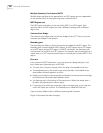
186 CHAPTER 8: STP OPERATION
a transitional state mechanism is then adopted to ensure the new configuration
BPDU has been propagated throughout the network before the root port and
designated port begin to send data again. That is, the root port and designated
port should undergo a transitional state for a period of Forward Delay before they
enter the forwarding state.
MSTP Overview The Switch 7750 implements the Multiple Spanning Tree Protocol (MSTP), which is
an enhancement to STP, and is compatible with both STP and RSTP. An MSTP
switch can recognize both STP and RSTP packets and can calculate the spanning
tree with them. Beside the basic MSTP functions, the Switch 7750 provides
additional MSTP features which include root bridge hold, secondary root bridge,
root protection, and BPDU protection.
STP cannot stabilize a network rapidly. Even on the point-to-point link or the edge
port, it takes an interval as long as twice the forward delay before the network
converges.
MSTP makes the network converge rapidly, and distributes the traffic of different
VLANs along their respective paths. This provides a better load-balance
mechanism for the redundant links.
MSTP associates VLAN with a spanning tree domain, and divides a switching
network into several regions, each of which has a spanning tree independent of
one another. MSTP prunes the network into a loopfree tree to avoid proliferation,
it also provides multiple redundant paths for data forwarding to implement the
VLAN data forwarding load-balance.
Configuring MSTP is described in the following sections:
■ MSTP Concepts
■ MSTP Principles
MSTP Concepts MSTP Concepts are described in the following sections
■ MST Region
■ VLAN Mapping Table
■ Internal Spanning Tree (IST)
■ Common Spanning Tree (CST)
■ Common and Internal Spanning Tree (CIST)
■ Multiple Spanning Tree Instance (MSTI)
■ MSTI Region root
■ Common Root Bridge
■ Boundary port
■ Port role
There are 4 MST regions in Figure 53.


















